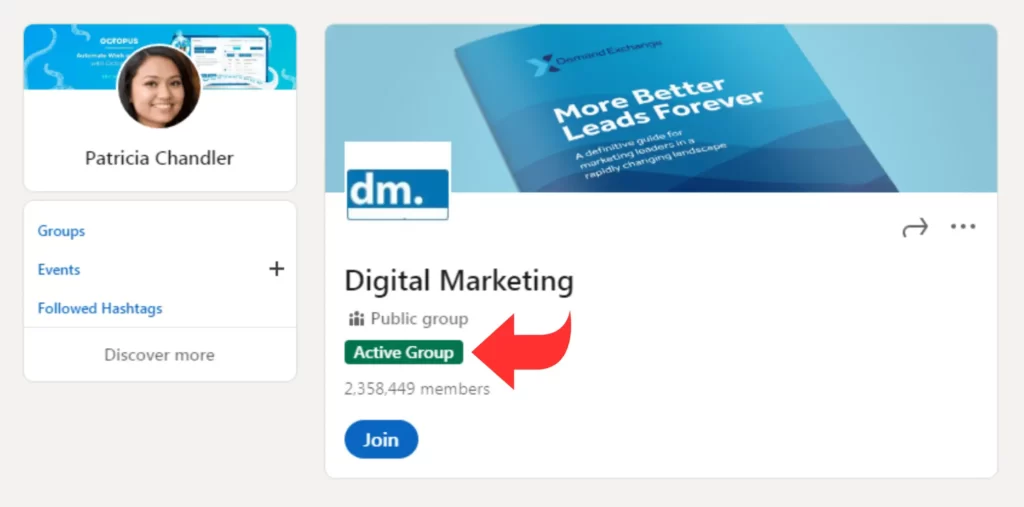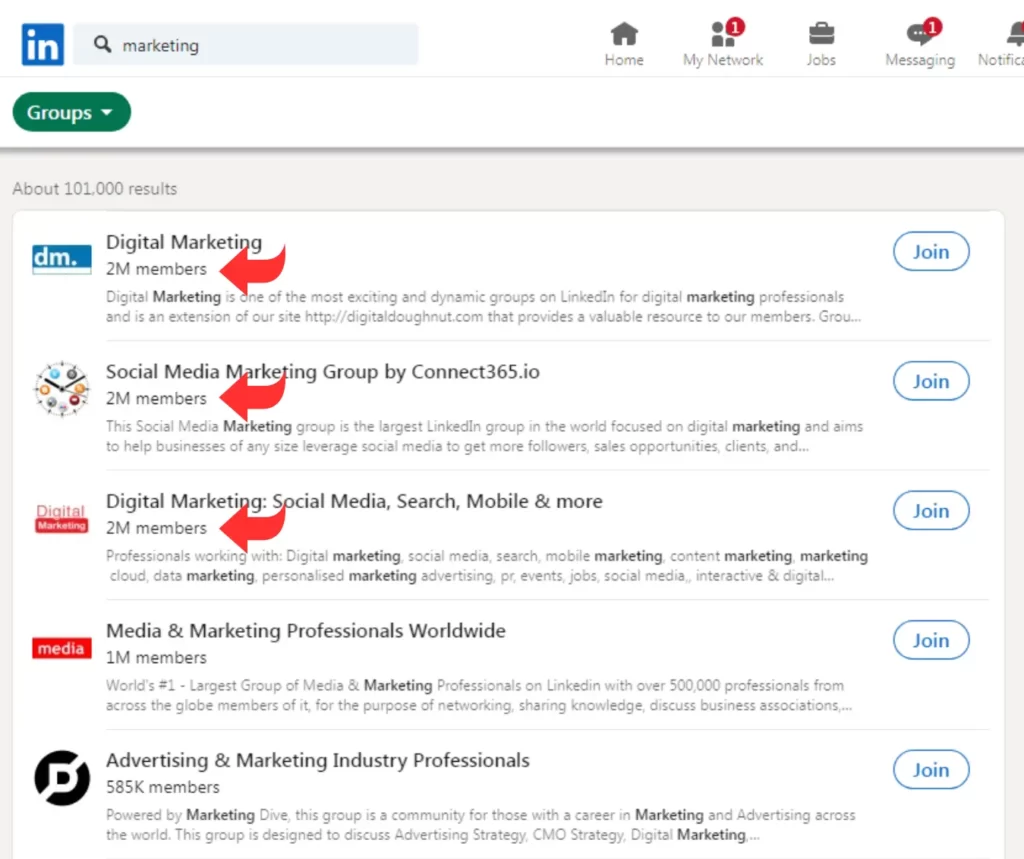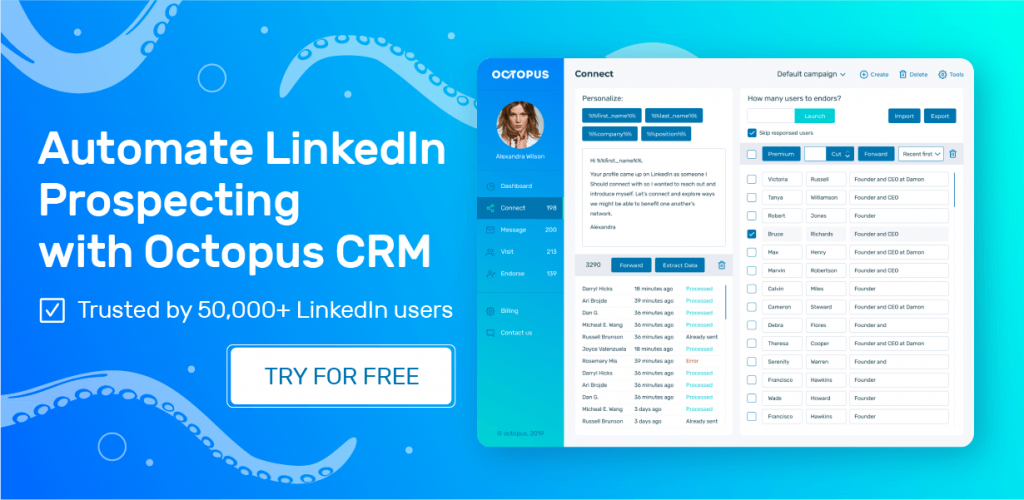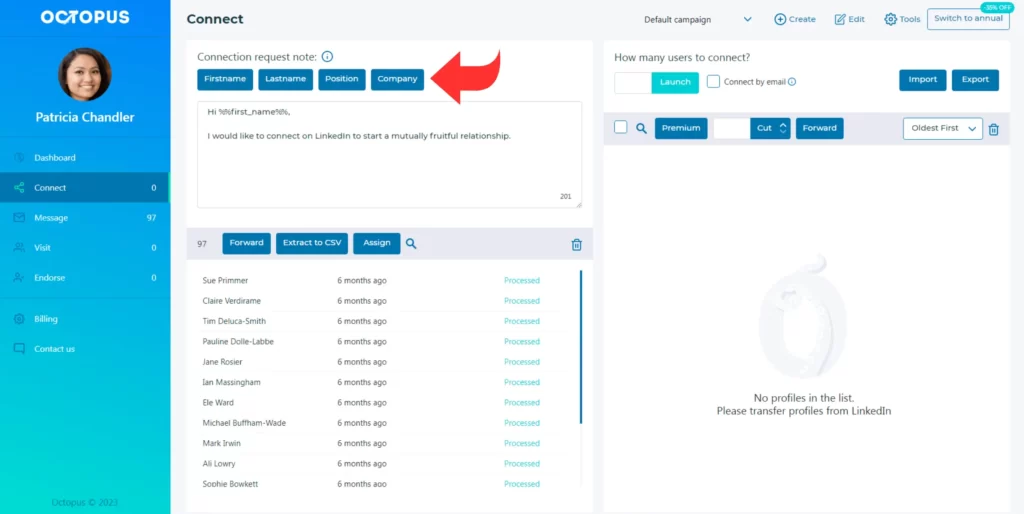Do you know that you can reach out people on LinkedIn without the need for direct connections? It’s true, and you can do this as a member of LinkedIn Groups. Being a member of up to 100 groups gives you the ability to send over 100 messages each day.
Tyron Giuliani, the Founder of Selling Made Social and a LinkedIn expert, has shared his four-step strategy for attracting high-intent leads from LinkedIn Groups.
Continue reading for a summary of the key insights of how to get high intent leads from LinkedIn Groups. We’ll share Tyron’s practical advice for creating an effective group outreach strategy, including:
- Key Considerations When Joining a Group
- Effective Tactics for Building Credibility and Engagement
- Adding Value to Ensure LinkedIn Invitation Acceptance
- Utilizing LinkedIn Automation to Scale Your Targeted Outreach

If you haven’t tried Octopus CRM yet, you can explore it with our 7-day free trial.
The Challenge
You might identify with this scenario: you conduct a search on LinkedIn, find possible leads, create message templates, and send them out to potential prospects, only to wait indefinitely for a response.
Thankfully, Tyron offers a solution to this problem!
Tyron advises focusing your efforts on prospects who genuinely intend to address a problem that your product, service, or solution can solve. He’s very straightforward about this: avoid investing time in LinkedIn users who have no intention of purchasing your offerings.
Instead of actively pursuing individuals, he recommends observing their behaviors to identify those displaying a genuine intent to address their issues. The good news is that Tyron has revealed several effective triggers for intent. In particular, he extensively shared one strategy, which he aptly calls the “Group Booster” method.
But how to use LinkedIn Group for lead generation? Well, you might be questioning the value of LinkedIn groups, given that many appear to be inactive. While this is true for some, it’s essential to recognize that among the three million LinkedIn groups, there are valuable opportunities.
Depending on the group’s focus and purpose, it may be teeming with individuals grappling with challenges or in need of solutions. When you become a part of such a group, you can access vital information, allowing you to offer relevant solutions.
Tyron has outlined a step-by-step guide on how to navigate this process effectively.
The Set-Up
Get started by joining up to 100 LinkedIn Groups. Don’t hesitate; join as many as you can.
In doing so, keep in mind that you can only have up to 20 pending requests at any given time. This means if you find a group to be inactive or slow in accepting your request, you’ll need to withdraw requests to join other groups.
Factors to Keep in Mind When Joining Groups
- Activity Level: Ensure the group is active and regularly updated.

- Member Demographics: Check if the group has a sufficient number of members matching your ideal client profile.

- Group Monitoring and Administration: Verify if the group is administered and if the administrators actively monitor and moderate group activities.
- Value-Driven Content: Assess the quality of group posts; prioritize groups with useful content over spam.
- Niche Focus: With over 3 million LinkedIn Groups available, explore those that align closely with your specific problem or solution. Integrate creative approaches in your group selection process.
Continue reading this article or explore our guide on how to generate leads on LinkedIn.

The Benefits of LinkedIn Groups
Here are some advantages of LinkedIn Groups that Tyron appreciates:
- Comprehensive Searchability: You can search for groups in Sales Navigator and use an array of filters to refine your results.
- Direct Messaging: You can initiate conversations with group members directly within the group, and no connection note is required. This means you can start chatting without the delays of connection requests.
- Effective Outreach: With the capability to send over 100 messages a day and achieve high response rates, it opens the door to numerous outreach opportunities.
- Differentiating Approach: Tyron emphasizes the importance of avoiding the common pitfalls of bombarding group members with unsolicited information or a self-centered approach.
Tactics: How to Get People in Groups to Respond

Tyron’s approach includes crafting messages with valuable content, having prepared prompts, and using transitional statements that are non-salesy and non-spammy.
- Develop a message that genuinely includes a “value-add“ content piece. Ensure it’s not just something you assume they’d like to hear; look for indications that they are interested in the content you’re providing.
- Prepare an initial outreach message with a prompt to kickstart the conversation.
- Create a second message that offers additional value to the recipient.
- Have a second prompt message ready to maintain engagement.
- Leverage transitional statements that are informative and respectful, steering clear of salesy or spammy language while encouraging responses.
Tyron’s implementation of this approach has yielded impressive results, with message return rates exceeding 55% for cold leads and over 85% for warm leads.
Step-by-Step Guide
Value Piece 1
When choosing which posts to share with the group, follow Tyron’s recommendation to capture a screenshot of each post.
Look for posts that meet the following criteria:
- Relevance to the group’s theme.
- Robust engagement, including comments and likes.
- Intriguing content. If it doesn’t captivate you, it may not captivate them.
- Diverse themes whenever possible.
- Incorporate compelling visuals such as graphs or tables presenting surprising or unconventional data (these tend to perform well).
- An aesthetically pleasing presentation. Consider the overall appearance of the document.
- Authentic thought pieces that provide unique insights related to the videos or articles shared within the group. Delve deeper; these can be more challenging to locate than you might anticipate.
Next steps:
- Once you’ve captured the post screenshots, arrange them into a document.
- Simultaneously, copy the text content of the posts into a separate document (you’ll use this later).
- Write a title for the document containing the screenshots. It is also a good idea to use a captivating hook to inform the group about the value they’ll gain from the posts.
For instance: “GROUP NAME’S TOP 4 POSTS: Insights from In-Depth Reading,” like “Direct Marketing’s Group TOP 4 POSTS ON HOW TO SUPERCHARGE OPEN RATES.”
At the end of the document, add your social media links and a statement highlighting the outcomes you deliver to clients.
Next, save the file to Google Drive and generate a shareable link.
Value Piece 2
- Use the text content from the posts to craft a supplementary piece of content for follow-up. This provides an additional opportunity to initiate a conversation.
- Approach each post individually and extract its key learning point. You may want to use AI tools for this task. AI models like ChatGPT and SloppyJoe summarize can be valuable in this regard. For more ways to use AI in your approach, explore this article ChatGPT for LinkedIn.
- Include a title for this content piece.
- At the bottom of the document, insert your contact details and clarify the outcomes you offer to clients.
- Save a copy of this content piece on Google Drive and generate a shareable link.
Keep reading or have a look at our guide on how to use ChatGPT for LinkedIn lead generation.
Overview of the Delivery
With both content pieces prepared, let’s explore how to deliver them to your group effectively.
Identifying Target Group Members
Start by identifying the group members you wish to reach out to. You can accomplish this using two methods:
- Option 1: Find them individually using Advanced Search and then return to the group to search for that specific member. Luckily, you can send a direct message to that prospect within the group without needing a prior connection. While this method may be time-consuming, it ensures that your message reaches their inbox.
- Option 2: Identify your potential prospects in Advanced Search and add them to a list. Then, use Octopus CRM LinkedIn automation tool to send a connection request with a tailored message to each person (we’ll guide you on the messaging later in this article). This approach requires sending a connection request before gaining messaging privileges, but it offers greater time efficiency.

Check out how to use Octopus CRM for LinkedIn lead generation.
Delivery
Here’s the messaging approach recommended by Tyron for Process 1. This sequence provides you with four opportunities to initiate a conversation.
For Process 2, you can use Octopus CRM to automate the entire process and establish a marketing funnel.
To gain access to Octopus CRM’s sales funnel feature, you’ll need to have a Free Trial or have a paid license of the software.
If you haven’t set up a marketing or sales funnel previously, you can refer to our straightforward tutorial to get started.
For a more in-depth understanding of crafting smart LinkedIn lead generation campaigns and assessing their effectiveness, you can explore this tutorial on the topic.
Transition
After starting the conversation, you have two choices to make:
Option 1
If you feel the need to establish a stronger rapport, you can explore Tyron’s “Pink Suit approach”. This method involves interrupting the conversation pattern and posing an irresistible question, one that is easy to answer and impossible to ignore. The goal is to keep the focus on the other person.
Option 2
The second option is to introduce a transitional presumably question to pave the way for a potential pitch.
Tyron emphasizes that the MAJORITY of leads may not be ready for your offer right away. People require time to get to know you and go through the process of getting to know, like, and trust you.
In any case, it’s crucial not to waste the effort invested in finding and messaging these individuals. You have found these prospects in a group that has shown interest in your offer, so it’s essential to keep them engaged. This is the stage where you must go the extra mile to help them become more familiar with you. When the timing is right, they’ll get in touch with you as you’d be on top of their minds.
Tyron’s approach involves categorizing these prospects into a ‘nurture list’ and implementing a messaging strategy known as the “nurture sequence”. It’s a straightforward and effective method.
Conclusion
As you can see, Tyron’s four-step approach presents a highly effective way to identify and engage with high-intent leads within LinkedIn Groups. When you use this method, it can open the doors to connecting with potential clients who have a real need for the solutions you offer. This strategy is not only practical but also incredibly valuable, offering a significant enhancement to your overall LinkedIn outreach efforts.
What’s more, this approach ensures that you’re not wasting your time and resources on individuals who aren’t interested in your services. Instead, you focus your energy on prospects who are actively seeking solutions, making your outreach efforts more productive and fruitful.
Tyron’s method acts as a valuable compass, guiding you towards leads that align with your offerings and are more likely to convert into satisfied clients. In a world where every minute counts, this strategy can be a game-changer, helping you make the most of your LinkedIn presence and achieve better results.
